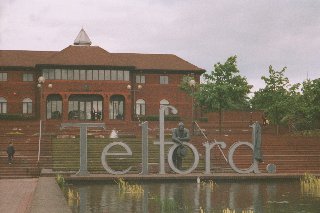Exploring Telford


|
Telford New Town lies a bit north of Birmingham, and west. A bit north of Wolverhampton, and west. Not as west as Shrewsbury, or Wales! On your map, follow the M1 motorway, then turn left onto the M6, then when the M6 turns North turn left again on to the M54, which was built to connect Telford to the motorway network. Telford is a New Town, formed over twenty five years ago by drawing a ring round the existing towns of Wellington, Oakengates, Donnington, Dawley, Madeley and Ironbridge, together with a lot of smaller villages, and filling in the gaps. It is, in my opinion as an incomer, a successful example of a developed New Town on the whole, although some people, especially residents who lived in the country where parts of Telford now are, would not agree. It has a population of over 125,000,making it easily the largest place in the rural county of Shropshire; in 1998, though, it ceased to part of Shropshire administratively and became Telford and Wrekin Unitary Authority. It has attracted a lot of high-tech Japanese and Taiwanese firms - Epson, Makita, NEC, Ricoh are examples - and people have moved here from all over the country in search of employment, with this much success, that unemployment here at the worst times has not been as bad as elsewhere in the industrial West Midlands. Internationally, its most famous feature is the iron bridge at Ironbridge, which was built across the River Severn in 1779 by local ironmaster Abraham Darby III. His grandfather, Abraham Darby I, was the first ironmaster to succeed in smelting iron using coke rather than charcoal. He developed an existing relatively small iron industry into the world's leading ironworks, earning the area the modern nickname of " The Birthplace of Industry". Abraham III presided over the resulting industry at its heyday, when the Coalbrookdale Company, and its rival the Lilleshall Company, owned mines, forges, works and farms all over the district. The resulting traffic led to demand for a new bridge over the Severn, and the world's first and most famous iron bridge, at the town which came to be called after it, was his outstanding achievement. The transport needs of this industry also led to the development of a complex network of canals, railways and tramways, and it was the author's interest in the whereabouts of these which was the inspiration for this site. The Ironbridge Gorge Museum records on several sites the heyday of the area as an industrial power. They include Darby's house, his blast furnace and a huge open-air site containing whole buildings furnished as for the turn of the century together with working industrial exhibits. The Museum is also the last place in the world where wrought iron is made, and they export it to Japan. Telford is named after Thomas Telford, engineer and architect. With its origins in the first Industrial Revolution and its name reflecting British endeavour, it is proud, now, to be at the forefront of the Information Age, which some have called the Second Industrial Revolution. |